User:Platonist Rainbow/sandbox
Brain Scientist Cartoon
Describe your media
It is a drawing of a brain
Is it your own work (Links to an external site.)?
Yes
What is the file format (Links to an external site.)?
It is an image .jpg
What license (Links to an external site.) have you chosen?
Attribution-ShareAlike 4.0 International (CC BY-SA 4.0)
What category/gallery (Links to an external site.) will you add it to?
https://commons.wikimedia.org/wiki/Category:Cartoon https://commons.wikimedia.org/wiki/Category:Brain
How will you describe (Links to an external site.) the file?
A cartoon of a brain
This article needs additional citations for verification. (February 2010) |
United Kingdom | |
| Value | 1⁄2 pound sterling |
|---|---|
| Mass | 3.99 g |
| Diameter | 19.30 mm |
| Edge | Milled |
| Composition | 22 Carat Gold |
| Gold | .1176 troy oz |
| Years of minting | 1817–present |
| Obverse | |
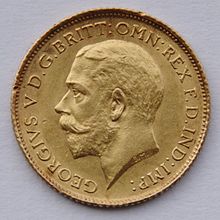 | |
| Design | Portrait of reigning monarch (George V obverse shown) |
| Reverse | |
 | |
| Design | Saint George and the Dragon |
| Designer | Benedetto Pistrucci |
The half sovereign is an English and later, British gold coin with a nominal value of half a pound sterling, or ten shillings. It is half the weight (and has half the gold content) of its counterpart 'full' sovereign coin.
Since the end of the gold standard, it has been issued only in limited quantities as a bullion or collectors' coin, with a sale price and resale value far in excess of its nominal value, though continues to be legal tender.
Modern half sovereigns, from 1817 onwards, have a diameter of 19.30 mm, a thickness of c. 0.99 mm, a weight of 3.99 g, are made of 22 carat (91+2⁄3%) crown gold alloy, and contain 0.1176 troy ounces (3.6575 g) of gold. The reverse side, featuring St. George slaying a dragon was designed by Benedetto Pistrucci, whose initials appear to the right of the date.[1]
Background and Authorisation
[edit]Henry VII revitalised England’s economy following a civil war and the Black Death[2]. He introduced the sovereign in 1489, which he valued at twenty shillings[3]. Before the new denomination, the only gold coins in circulation were angels and half angels[4].
Henry VII left a large treasury - the modern equivalent of about £375 million - to his successor Henry VIII, however the inherited wealth was not sustained due to Henry VIII’s extravagant lifestyle and the war expenses needed to maintain a claim over France[2]. Before the Reformation, minting was still carried out by monasteries. Due to a shortage of bullion imported from overseas - Cardinal Wolsey, Chancellor of Exchequer began debasing coinage in 1526 in an attempt to align England’s currency with that of continental Europe. Henry VIII realised he was able to increase his revenue if he continued debasing coins – reducing their fineness, and by introducing new denominations[3]. This decision earned him the nickname “Old Coppernose”, describing the copper showing through parts of his portrait that were of low relief on his basest coinage after only a short time in circulation[2]. The era 1542-1551 is now known as the Great Debasement[2].
The coinage of Henry VIII can be divided into five classes. The half sovereign valued at ten shillings was introduced in the third alongside the quarter-angel[3].
The half sovereign continued to be used by Henry VIII’s successor Edward VI. During the reign of Elizabeth I, James I, and Charles I, ten shilling coins were issued in the denominations of half pounds and half unites[4]. Sovereigns and half sovereigns were not to re-emerge until 1817[4].
George III ascended in 1760, and by 1801 was the monarch of a United Great Britain and Ireland[2]. Revolutionary war was breaking out, with 13 of the American colonies declaring themselves independent in retaliation to heavy taxation by Britain[2]. The Anglo-French war devastated the British economy, to which the Bank of England responded by issuing banknotes in place of gold coinage for the first time. There was also a surge in Spanish eight reales stamped with the King’s image and the issuing of copper tokens by British businesses[2].
William Wellesly Pole was appointed Master of the Mint in 1812[4]. Due to the Napoleonic wars, large amounts of gold had left Britain. Pole responded by suggesting new gold coinage of ten shilling, twenty shilling, forty shilling and five-pound pieces, which constituted the Great Recoinage approved in 1816[4]. The modern sovereign and half sovereign featuring the famous design by Benedetto Pistrucci of St George slaying the dragon was proclaimed as currency in 1817, and minting commenced later that year[3].
Mintage of the denominations has continued since, with no alterations in weight and fineness[3].
Economics and Circulation
[edit]1544
[edit]Half Sovereigns were part of the third class of coinage introduced by Henry VIII in 1544 (Michael A. Marsh (Revised by Steve Hill), 2017). As well as an increase in the value of gold of 10% in 1526[5], the standard fineness of coins was debased so that the sovereign valued at twenty shillings weighed 192 grains (12.4 grams) compared to 240 grains (15.6 grams) when Henry VIII began his reign (Michael A. Marsh (Revised by Steve Hill), 2017). The half sovereign which weighs 96 grains (6.2 grams), replaced the ryal valued at ten shillings (Michael A. Marsh (Revised by Steve Hill), 2017). The debasement of gold coins began at 23 carats ending at 22 carats fineness (0.96 fine) (Michael A. Marsh (Revised by Steve Hill), 2017).
Design and Production
[edit]1544-1547
[edit]Half sovereigns were first produced during the reign of Henry VIII[3]. The half sovereign of Henry VIII measures at 30mm in diameter and weighs 100 or 19 grains (6.22 grams)[5]. In 1544-1547, three different half sovereigns were minted at the Tower, Sothwark and Bristol mints; therefore, each featured the mint marks of their respective mints[5]. Marsh describes the obverse of these half sovereigns: “…featuring the portrait of a crowned King Henry VIII seated in his chair of state holding his sceptre and orb, the Tudor rose at his feet.”[3] The reverse features a crowned shield held by a lion and dragon.
1547-1553
[edit]These coins were struck at the Tower and Southwark mints during the reign of Edward VI and the half sovereigns exclusively feature his youthful portrait[4]. Aside from featuring the portrait of Edward VI, the addition of "EDWARD VI" to the legend and featuring different mint marks, half sovereigns of this time do not differ from previous issues.
From 1549-550 half sovereigns minted at the Tower mint, and Durham House featured an uncrowned bust of Edward VI on the obverse. at London, Southwark and Durham House mints struck half-length crowned busts of the king[5].
From 1550-1553, fineness of gold coins was increased to 23 carats. The Half sovereign featured a crowned King Edward VI in armour, holding a sceptre and sword on the obverse. The reverse features a crowned shield of heraldic arms[5].
1603
[edit]The first coinage of James I commenced in 1603 and features a crowned bust on the obverse, and a crowned shield on the reverse and thistle mint mark[5].
1816-1820
[edit]The 1817 half sovereign features the portrait of George III wearing a laurel wreath on the obverse and a crowned shield on the reverse and are the first milled half sovereigns[5]. These sovereigns are considered the modern half sovereign
1820-1830
[edit]The first type of half sovereign minted during the reign of George IV features his portrait wearing a laurel wreath on the obverse and an ornately garnished crowned shield on the reverse. A second type differs in that the shield on the reverse is plain, whilst the third type features a bare headed king. Another type is similar to the third, but has an extra tuft of hair in the portrait and a heavier border[5].
1830-1837
[edit]The small size half sovereign is 17.9mm in diameter and features a bare head bust of William IV on the obverse and a crowned shield and mantle on the reverse. These coins were struck with both plain and milled edges.
The large size half sovereign measures 19.4mm in diameter with a similar design.
There was also an error struck from a Sixpence die. [5]
Victoria, 1837-1901
[edit]Young Head Coinage, 1838-1887
[edit]Coinage from this era features a youthful portrait of Victoria on the obverse, of which there were five variations. Half sovereigns featured a shield reverse and also had many types. The type A2 features the second head of Victoria with the date below on the obverse, and the die number below the shield on the reverse. The type A3 featured the third and larger portrait. Type A4 features the fourth young head which has a hair ribbon. Type A5 features the fifth young head which shows no front ear lobe. Mintage of half sovereigns also commenced in Australia at this time. [5]
Jubilee Coinage 1887-1893
[edit]Coinage features an older crowned bust of Victoria on the obverse and shield reverse. [5]
Old head coinage 1893-1901
[edit]The obverse features an old veiled bust, and the reverse features the famous design of St. George slaying the dragon for the first time on a half sovereign. [5]
1901-1910
[edit]The coin features a bare head bust of Edward VII on the obverse and St. George reverse. Coins were minted in London, Melbourne, Perth and Sydney.[5]
1910-1936
[edit]The coin features a bare head bust of George V on the obverse and a St. George reverse.[5]
1936-1952
[edit]The coin features a bare head bust of George VI on the obverse and St. George reverse, and only plain edge coins were minted.
Benedetto Pistrucci's St George Slaying the Dragon
[edit]As Myatt and Hanley describe, the design of St George slaying the dragon is an example of a numismatic motif, with a similar design being used in 320 BC on a silver Macedonian coin and appearing on later Roman coinage[6]. St George was made England’s patron saint by Richard the Lionheart[6]. The design on sovereigns and half sovereigns issued during the reign of George III, features his namesake saint slaying the Napoleonic dragon of Waterloo.[6]
The Italian die-cutter responsible – Benedetto Pistrucci was appointed as an assistant engraver at the Royal Mint on June 26, 1816[3]. After the death of Chief Engraver Thomas Wyon in 1817, Pistrucci took over his duties, however, his Italian ethnicity prevented him from inheriting Wyon’s official title[3]. Pistrucci’s wax models of St George could not be reproduced by any of the Mint engravers, so his original design was used in 1817[3]. The design features a classic Greek warrior on horseback and was such a success with the public, it eventually did earn Pistrucci the title of Chief Engraver at the Royal Mint[6].
The original design was continued into the reign of George IV[3], however, whilst the design was used for sovereigns, it only commenced to be featured on half sovereigns in 1893 during the reign of Victoria.[5]

Orientation of Effigees/Busts
[edit]As J.J. Cullimore Allen states in Sovereigns of the British Empire,
“As is well known, it has long been the tradition that the effigee or bust of each succeeding monarch faces in the opposite direction to that of the predecessor. The result of this custom, as they affect the sovereign [and half sovereign], are as follows:
George III faces to the right
George IV faces to the left
William IV faces to the right
Victoria faces to the left
Edward VII faces to the right
George V faces to the left
Edward VIII faces to the left
George VI faces to the left
Elizabeth II faces to the right.”
(Allen, James John Cullimore, 1965)
There is a break in consistency of this custom from Edward VIII to George VI, however, the Royal Mint proceeded with the custom following the ascension of George VI as though there had been none (Allen, James John Cullimore, 1965).
The Australian Half Sovereign
[edit]In response to large amounts of unrefined gold circulating during the Gold Rush, the Sydney Mint was approved in 1853 and opened in 1855; thus, the Sydney General Hospital became the first overseas branch of the London Royal Mint (Royal Mint, Sydney, n.d.).
Bullion and mintages were reclaimed by the British economy and sent via ship to Europe (Mary Poovey, 2003).
Modern Bullion and Collector's Coins
[edit]Specimens and Mintages
[edit]| Date | Type/Variety | Obverse | Reverse | Coins Minted |
|---|---|---|---|---|
| 1817 | Normal | 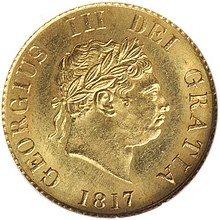
|
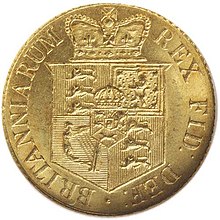
|
2,080,197 |
| 1817 | Proof (WR204) | Not Known | ||
| 1818 | Normal | 1,030,286 | ||
| 1818 | Proof (WR205) | Not Known | ||
| 1818/17 | Obv. Overdate 18 over 17 | Not Known | ||
| 1820 | Normal (note: the zero sometimes varies in size) | 
|
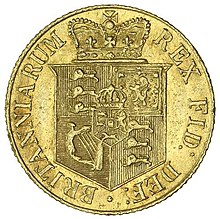
|
35,043 |
| 1820 | Patterns (WR206-7) | Not Known |
| Date | Type/Variety | Obverse | Reverse | Coins Minted |
|---|---|---|---|---|
| 1821 | Normal | 
|

|
231,288 |
| 1821 | Proof (WR 244) | Not Known |
| Date | Type/Variety | Obverse | Reverse | Coins Minted |
|---|---|---|---|---|
| 1823 | Normal | 224,280 | ||
| 1823 | Proof (WR 245) | Not Known | ||
| 1824 | Normal | 591,538 | ||
| 1824 | Proof (WR 246) | Not Known | ||
| 1825 | Normal | 
|
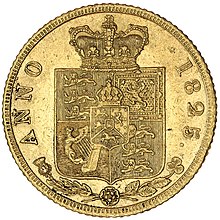
|
761,150 |
| Date | Type/Variety | Obverse | Reverse | Coins Minted |
|---|---|---|---|---|
| 1825 | Proof (WR 248) | Not Known | ||
| 1826 | Normal | 344,830 | ||
| 1826 | Proof (WR 249) | Not Known | ||
| 1826 | Hair curls differ (extra tuft of hair) | Not Known | ||
| 1826 | Proof. Hair curls differ | Not Known | ||
| 1827 | Normal | 492,014 | ||
| 1827 | Proof (WR 250) | Not Known | ||
| 1827 | Hair curls differ | Not Known | ||
| 1828 | Normal | 
|
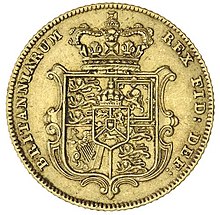
|
1,244,754 |
| 1828 | Proof (WR 251) | Not Known | ||
| 1828 | Hair curls differ | Not Known | ||
| 1829 | Proof (WR 252) | Unique | ||
| 1829/1823 | Mule. Pattern (WR 253) | Not Known |
| Date | Type/Variety | Obverse | Reverse | Coins Minted |
|---|---|---|---|---|
| 1831 | Small size proof plain edge (WR 267) | Not Known | ||
| 1831 | Small size Milled edge proof (WR 268) | Not Known | ||
| 1834 | Small size (17.9mm) | 133,899 | ||
| 1835 | Normal size (19.4mm) | 
|

|
772,554 |
| 1836 | Normal size (19.4mm) | 146,865 | ||
| 1836 | Obv. struck from sixpence die (19.4mm) | Not Known | ||
| 1827 | Normal size (19.4mm) | 160,207 | ||
| 1837 | Proof (WR 269) |
| Date | Type/Variety | Overse | Reverse | Coins Minted |
|---|---|---|---|---|
| 1838 | Obv. I Small bust | 273,341 | ||
| 1839 | Plain edge proof. Die axis ↑↓ (WR343) | Not known | ||
| 1839 | Plain edge proof. Die axis ↑↓ (WR344) | Not known | ||
| 1839 | Milled edge proof (WR345) | Not known | ||
| 1841 | Normal | 508,835 | ||
| 1842 | Normal | 2,223,352 | ||
| 1843 | Normal | 1,251,762 | ||
| 1844 | Normal | 
|

|
1,127,007 |
| 1845 | Normal | 887,526 | ||
| 1846 | Normal | 1,063,928 | ||
| 1847 | Normal | 928,656 | ||
| 1848 | Normal | 410,595 | ||
| 1848/7 | Obv. I Overdate. 8 over 7 | Not known | ||
| 1848 | Wide spaced date figures | Not known | ||
| 1848 | Close grouped date figures | Not known | ||
| 1849 | Normal | 845,112 | ||
| 1850 | Normal | 179,275 | ||
| 1851 | Normal | 773,575 | ||
| 1852 | Normal | 1,377,671 | ||
| 1853 | Normal | 2,708,796 | ||
| 1853 | Proof.Small date (WR346) | Not known | ||
| 1853 | Proof.Large date(WR347) | Not known | ||
| 1855 | Normal | 1,120,362 | ||
| 1856 | Normal | 2,391,909 | ||
| 1856/5 | Obv.1. Overdate. 6 over 5 | Not known | ||
| 1857 | Normal | 728,223 | ||
| 1858 | Obv. 2. Slightly larger bust
Rev. Garnished shield with dot |
855,578 | ||
| 1859 | Normal | 2,203,813 | ||
| 1860 | Normal | 1,131,500 | ||
| 1861 | Normal | 1,130,867 | ||
| 1862 | Normal | Not known | ||
| 1863 | Normal | Not known | ||
| 1871 | Obv. 2. Bust slightly turned
Rev. Garnished shield without dot |
Not known | ||
| 1876 | Obv. 4. Enlarged bust | Not known |
| Year | Coins minted |
|---|---|
| 1982 | 2,500,000 |
| 1983–1999 | limited edition proofs only |
| 2000 | 146,822 |
| 2001 | 94,763 |
| 2002 | 61,347 |
| 2003 | 47,818 |
| 2004 | 34,924 |
| 2005 | 30,299 |
Counterfeiting
[edit]The half sovereign is a "protected coin" for the purposes of Part II of the Forgery and Counterfeiting Act 1981.[7]
See also
[edit]- Quarter sovereign - introduced in 2009
References
[edit]- ^ https://www.ngccoin.com/price-guide/world/great-britain-1-2-sovereign-km-819-1911-1915-cuid-1129956-duid-1327263
- ^ a b c d e f g Whittington, Bob (2017). Money Talks. Scotland, UK: Whittles Publishing. pp. 76–95.
- ^ a b c d e f g h i j k l m n o p q Marsh, Michael A. (2017). The Gold Sovereign. Exeter, Devon: Token Publishing (Revised Ed.). pp. 109–177.
- ^ a b c d e f Seaby, Peter (1985). The Story of British Coinage. London: Seaby Publishing. pp. 81–100.
- ^ a b c d e f g h i j k l m n o Coins of England & The United Kingdom. London: Spink & Son LTD. 2019. p. 237.
{{cite book}}:|first=missing|last=(help) - ^ a b c d Myatt & Hanley, Bill & Tom (1980). Australian Coins, Notes & Medals. Melbourne, Australia: Castle Books.
- ^ The Forgery and Counterfeiting Act 1981, section 27(1), as read with the Forgery and Counterfeiting (Protected Coins) Order 1981 (S.I. 1981/505), article 2 and Schedule
External links
[edit]- British Coins - Free information about British coins. Includes an online forum.
- Online Coin Club / Coins from United Kingdom / Half Sovereign (Pre-Decimal)
Category:English gold coins
: Category:British gold coins :Category:Coins of Australia :Category:1544 introductions Category:1544 establishments in England Category:Bullion coins
Category:Half-base-unit coins




